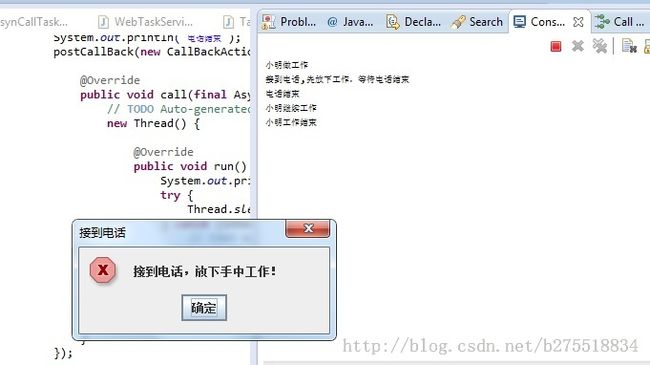java android异步编程小技巧,简洁易懂业务异步流程设计
代码下载:http://download.csdn.net/detail/b275518834/7937005
我们在开发前台的时候经常遇到各种各样异步的处理。
比如耗时的操作放到线程里,如果需要询问用户,然后再继续线程。该怎么做呢?
如安装向导,服务器等待应答,错误回滚,重定向新的游戏服务器
代码当然不难,可是异步的代码非常的难看,synchronized和唤醒跳转关系,让代码阅读困难。
尤其在android有AsynTask 和Handler,不怕实现就怕维护。
我这里介绍我工作中遇到的问题,我写了个的demo来重构自己的代码。
例子:我们生活中经常遇到很多异步处理,小明在工作,突然接到电话,小明放下手中的工作,接完电话小明继续工作
分析:执行线程,弹出对话框,等待用户输入,继续执行线程中剩余动作。
如图
第一遍编写-失败案例,整个代码中充满await()和astart();方法业务逻辑无法体现
package com.test;
import java.util.concurrent.locks.Condition;
import java.util.concurrent.locks.ReentrantLock;
import javax.swing.JOptionPane;
//常规写法
public class Test {
public static ReentrantLock lock = new ReentrantLock();
public static Condition condition = lock.newCondition();
public static void main(String[] args) throws InterruptedException {
// TODO Auto-generated method stub
new Thread() {
@Override
public void run() {
System.out.println("小明在工作");
timerWait(5000);
System.out.println("小明接到电话,放下工作");
astart();
await();
System.out.println("小明继续工作");
timerWait(2000);
astart();
}
}.start();
System.out.println("主线程堵塞");
await();
JOptionPane.showMessageDialog(null, "接到电话,放下工作", "消息提示",
JOptionPane.ERROR_MESSAGE);
astart();
System.out.println("小明工作结束结束");
}
private static void await() {
lock.lock();
try {
condition.await();
} catch (InterruptedException e) {
// TODO Auto-generated catch block
e.printStackTrace();
}
lock.unlock();
}
private static void astart() {
lock.lock();
condition.signal();
lock.unlock();
}
private static void timerWait(int i) {
// TODO Auto-generated method stub
try {
Thread.sleep(1000);
} catch (InterruptedException e) {
// TODO Auto-generated catch block
e.printStackTrace();
}
}
}
主函数 这是重构以后,将业务逻辑和跳转关系明确出来
package com.demo;
import javax.swing.JOptionPane;
//流程写法
public class MainTest_AsynCallTask {
public static void main(String[] args) {
new AsynCallTask() {
@SuppressWarnings("unused")
public void call1() throws InterruptedException {
System.out.println("小明做工作");
Thread.sleep(2000);
}
@SuppressWarnings("unused")
public void call2() throws InterruptedException {
System.out.println("接到电话,先放下工作,等待电话结束");
JOptionPane.showMessageDialog(null, "接到电话,放下手中工作!", "接到电话",
JOptionPane.ERROR_MESSAGE);
Thread.sleep(2000);
}
@Override
protected synchronized boolean excute(int state) {
switch (state) {
case 0:
postStateByMethod("call1", 1);
break;
case 1:
postStateByMethod("call2", 2);
break;
case 2:
System.out.println("电话结束");
postCallBack(new CallBackAction() { //如何在一个新线程中唤醒 <span style="font-family: Arial, Helvetica, sans-serif;">excute(int state)</span>
@Override
public void call(final AsynCallTask task) {
// TODO Auto-generated method stub
new Thread() {
@Override
public void run() {
System.out.println("小明继续工作");
try {
Thread.sleep(2000);
} catch (InterruptedException e) {
// TODO Auto-generated catch block
e.printStackTrace();
}
postExcute(3);
}
}.start();
}
});
break;
default:
System.out.println("小明工作结束");
return false;
}
return true;
}
};
}
}
封装类
package com.demo;
import java.util.concurrent.ExecutorService;
import java.util.concurrent.Executors;
import java.util.concurrent.locks.Condition;
import java.util.concurrent.locks.ReentrantLock;
public abstract class AsynCallTask implements Runnable {
/**状态码*/
protected int state;
/**重入锁*/
private ReentrantLock lock = new ReentrantLock();
/**线程锁条件*/
private Condition condition = lock.newCondition();
/**获得自身引用,在postStateByMethod方法中方便获取获取class*/
private AsynCallTask task;
/**最大值为2的线程队列*/
private ExecutorService service = Executors.newFixedThreadPool(2);
{
task=this;//获得自身引用
service.submit(this);//执行自身线程
}
/**最大值为2的线程队列*/
@Override
public void run() {
// TODO Auto-generated method stub
while(excute(state));//重复进入excute(state)方法直到return false
service.shutdown();//执行结束时关闭队列
service=null;
task=null;
}
protected abstract boolean excute(int state);
/**当前线程等待*/
protected final void stop() {
lock.lock();
try {
condition.await();
} catch (InterruptedException e) {
// TODO Auto-generated catch block
e.printStackTrace();
}
lock.unlock();
}
/**唤醒其他线程*/
protected final void start() {
lock.lock();
condition.signalAll();
lock.unlock();
}
/**设置状态码并且唤醒其他线程*/
protected final void postExcute(Integer state) {
this.state = state;
start();
}
/**等待AsynCallTask run方法,执行一段新的Run方法*/
protected void postCallBack(CallBackAction run) {
lock.lock();
service.submit(run);
stop();
lock.unlock();
}
/**等待AsynCallTask run方法,指定方法执行*/
public void postByMethod(final String str) {
postCallBack(new CallBackAction() {
@Override
public void call(AsynCallTask task) {
try {
task.getClass().getMethod(str).invoke(task);
} catch (Exception e) {
// TODO Auto-generated catch block
e.printStackTrace();
}
}
});
}
/**等待AsynCallTask run方法,指定方法执行,结束后指定状态码唤醒AsynCallTask的run方法*/
public void postStateByMethod(final String str,final int state) {
this.state=state;
postCallBack(new CallBackAction() {
@Override
public void call(AsynCallTask task) {
try {
task.getClass().getMethod(str).invoke(task);
} catch (Exception e) {
}
postExcute(state);
}
});
}
/**等待回调接口*/
private interface CallBack extends Runnable {
public void call(AsynCallTask task);
}
public abstract class CallBackAction implements CallBack {
@Override
public final void run() {
call(AsynCallTask.this);
}
@Override
public abstract void call(AsynCallTask task);
}
}
package com.test.asyn;
import android.app.Activity;
import android.app.AlertDialog;
import android.app.AlertDialog.Builder;
import android.content.DialogInterface;
import android.content.DialogInterface.OnClickListener;
import android.os.Bundle;
import android.widget.ProgressBar;
import android.widget.SeekBar;
public class StartActivity extends Activity{
SeekBar bar;
@Override
protected void onCreate(Bundle savedInstanceState) {
// TODO Auto-generated method stub
super.onCreate(savedInstanceState);
setContentView(R.layout.main);
bar=(SeekBar) findViewById(R.id.seekbar);
new AsynCallTask() {
public void progress() throws InterruptedException{
for(int i=0;i<80;i++)
{
bar.setProgress(i);
Thread.sleep(50);
}
}
public void back() throws InterruptedException{
for(int i=bar.getProgress();i>0;i--)
{
bar.setProgress(i);
Thread.sleep(50);
}
}
public void showDialog(){
bar.post(new Runnable() {
@Override
public void run() {
// TODO Auto-generated method stub
AlertDialog.Builder builder = new Builder(StartActivity.this);
builder.setMessage("发生了一个错误确认退出吗?");
builder.setTitle("询问用户");
builder.setPositiveButton("确认", new OnClickListener() {
@Override
public void onClick(DialogInterface d, int arg1) {
// TODO Auto-generated method stub
postExcute(2);
}
});
builder.create().show();
}
});
}
@Override
protected boolean excute(int state) {
// TODO Auto-generated method stub
switch (state) {
case 0:
postStateByMethod("progress",1);//执行线程
break;
case 1:
postByMethod("showDialog");//错误提示
break;
case 2:
postStateByMethod("back",-1);//回滚
break;
default:
return false;
}
return true;
}
};
}
}
代码下载:http://download.csdn.net/detail/b275518834/7937005
